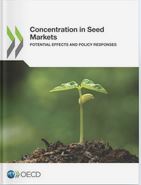 Topics Topics |
|
|
|
 Species Species |
|
|
|
|
|
Global food prices continue to drop - Prices of cereals and oils decrease – FAO expects bumper cereal harvest this year
Rome, Italy
September 5, 2013
The FAO Food Price Index dropped for the fourth month in a row in August reaching its lowest level since June 2012.
The index, which measures the monthly change in the international prices of a basket of food commodities, averaged 201.8 points in August 2013, nearly 4 points (1.9 percent) below its July value and 11 points (or 5.1 percent) less than in August 2012.
Last month's decline was mainly driven by continued falls in the international prices of cereals and oils. Dairy, meat and sugar prices rose slightly.
Steep decline in cereal prices
The FAO Cereal Price Index averaged 210.9 points in August, down 16.4 points (7.2 percent) from July and 49.4 points (or 19 percent) from August 2012.
The steep decline reflects expectations for a strong growth in world cereal production this year and, especially, a sharp recovery in maize supplies.
Oils, dairy and meat
The FAO Oils/Fats Price Index averaged 185.5 points in August, 5.7 points (or 3.0 percent) below the July value and the third consecutive monthly decline.
The FAO Dairy Price Index averaged 239.1 points in August, 2.8 points (1.2 percent) more than in July and 37 percent above its level in August last year. Prices increased last month for all the dairy products that make up the index, except butter, as export supplies remain limited in major trading countries.
The FAO Meat Price Index averaged 175.0 points in August, an increase of 2.2 points (1.3 percent).
Bumper harvest expected
Together with the Food Price Index, FAO released a new forecast of world cereal production in 2013. This is expected to rise to 2 492 million tonnes. The forecast has been revised upwards by 14 million tonnes (or 0.5 percent) from the July forecast as a result of higher maize crops officially reported in Argentina and improved prospects in the EU and Ukraine.
At the latest forecast level, global cereal production would be 179 million tonnes (7.7 percent) higher than in 2012 and a new record.
The recovery is predicted to be driven by a 10.5 percent expansion in coarse grain output to 1 285 million tonnes as well as a 7.6 percent rise in wheat production to 710 million tonnes.
World rice production is set to increase by 1.3 percent, reaching a new high of 497 million tonnes, in milled equivalent.
US maize production bounces back
The sharp increase in global production of coarse grains in 2013 would be largely on account of a strong rebound in maize output (to 983 million tonnes), the bulk of which would originate from the United States, where maize production is forecast to reach 343 million tonnes this year, some 25 percent (69 million tonnes) higher than the 2012 drought-reduced level.
Cereal utilization
Global cereal utilization in 2013/14 is projected at 2 413 million tonnes, down marginally from the previous forecast, but still 3.2 percent higher than in 2012/13.
Based on the latest forecasts, total use of cereals for direct human consumption is set to expand by 1.2 percent to 1 094 million tonnes. This would result in global per capita cereal consumption remaining steady at just over 152 kg, with wheat at 67 kg and rice at close to 57 kg.
Cereal stocks
The forecast of world cereal stocks at the close of seasons in 2014 has been raised slightly since July, to 569 million tonnes, primarily on expectations of higher maize inventories. The revised forecast puts world cereal stocks 13 percent (65.5 million tonnes) above their low opening levels and at their highest since 2001/02
Based on the current projections of overall demand, the increase in stocks would drive up the global stock-to-use ratio to 23.3 percent, the highest since 2002/03.
"The overall supply-demand situation for cereal markets is much improved over this time last year when drought-hit production and low stock-to-use ratios, especially for maize, raised serious concerns," said David Hallam, Director of FAO's Trade and Markets Division. "Production appears to have rebounded and higher stock-to-use ratios should bring greater stability to world markets."
More news from: FAO (Food and Agriculture Organization)
Website: http://www.fao.org Published: September 5, 2013 |
|
|
|
Better Food Venture's
AgTech Landscape 2019

|
| |
|
2019 THRIVE Top 50
landscape map

|
| |
|
Concentration in Seed Markets - Potential Effects and Policy Responses

(OECD December 2018)
|
|
Visualizing Consolidation
in the Global Seed Industry
1996–2018

Seed Industry Structure
1996-2018
Phil Howard
Associate Professor
Michigan State University
|
|
2017 Seed Company Family Tree
Ccreated Septebmer 2017
by Robert Walsh
WaSoo Farm, Elk Point, South Dakota |
 |
Syngenta Brands Family Tree
Ccreated January 2017 by Robert Walsh, WaSoo Farm, Elk Point, South Dakota
|
 |
| |
Rabobank's
World Vegetable Map 2018 |
 |
|
|